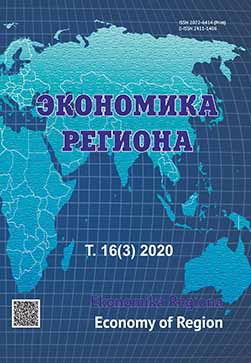Экономическая оценка факторов роста производительности труда на градообразующих предприятиях ОПК: влияние на моногорода
Economic Assessment of Growth Factors of Labour Productivity at Core Enterprises of the Defence Industry: Impact on Single-Industry Towns
Author(s): Valery Dubrovsky, Ekaterina Mikhailovna Ivanova, Natalia ChuprakovaSubject(s): Economy
Published by: Институт экономики Уральского отделения Российской академии наук
Keywords: labour productivity; capital-labour ratio; fixed assets; active part of fixed assets; defence industry enterprises; Rosatom State Corporation; investments; non-core assets; technical equipment
Summary/Abstract: The insufficient growth of labour productivity at the enterprises of the Russian defence industry compared to the world level results in the need to identify the causes of the current situation. In recent years, the military rearmament led to the use of new technologies in production, personnel reduction, and, ultimately, to the increase in labour productivity. Nevertheless, the growth of the target value due to a decrease in the number of employees has mixed effects on the development of the socio-economic environment of single-industry towns. As an information base for the study, we used the statistical data of six core enterprises of ROSATOM State Corporation for the period from 2008 to 2017. The paper relies on Russian and foreign research focused on measuring the impact of various factors on labour productivity. We applied correlation-regression analysis and index method of factor analysis. As a result, we built a multiple linear model of the dependence of labour productivity on the average headcount, capital-labour ratio of active business assets, the ratio of the active part of assets in their total value, and investments. Further, we examined the statistically significant difference of the multiple linear regression model and its parameters and confirmed the applicability of the postulated model for predicting indicators values. The index analysis of labour productivity as well as indices of capital-labour ratio and capital productivity revealed a discrepancy between the growth of an indicator and the increase in the utilisation efficiency of fixed assets in dynamics. Additionally, it indicated the need to compare labour productivity factors with performance indicators when predicting the development of enterprises. The conducted research and constructed model can be used for developing strategic plans for the defence industry enterprises, as well as for considering how the changes in labour productivity and personnel of the core enterprises of the defence industry influence the economy of single-industry towns.
Journal: Экономика региона
- Issue Year: 16/2020
- Issue No: 3
- Page Range: 831-844
- Page Count: 14
- Language: Russian

